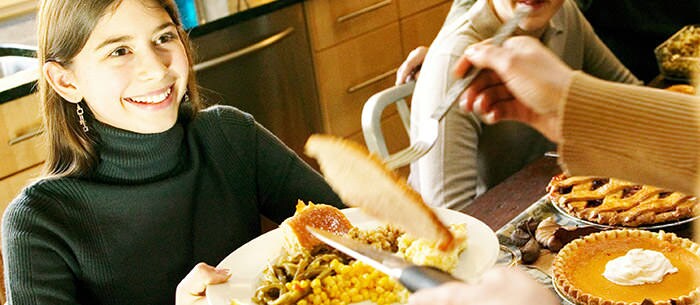Thanksgiving Day is so much more than the Macy’s parade, a great meal, and a football game. Above all else, Thanksgiving is a day for us to feel truly grateful and appreciative of all that we have in our lives. As adults, this is a pretty easy concept to get, but for kids, the message isn’t quite as clear yet. So, how do we teach children about the importance of being thankful?
We asked some parenting experts to share their tips for how parents and caregivers can teach kids about the true meaning of Thanksgiving. Here’s what they had to say:
-
Play the Gratitude Game
Lennay Chapman, author of “Secrets to a Rockin Life” has created a game called “The Gratitude Game.” The game needs ideally three or more players and one person to serve as a timekeeper. Have everyone sit in a circle with one person starting off saying, “I am grateful for [fill in the blank].” That person has five seconds to come up with something for which they are thankful, whether it be their favorite stuffed animal, food or activity. As soon as the first person finishes, the person to the left goes. “The key is to say what you are grateful for without repeating, and without pausing for more than five seconds,” says Chapman.
-
Get Creative With a Thankfulness Jar
Robert Nickell, founder and author of DaddyScrubs.com, suggests putting a little creativity in incorporating thankfulness into the holiday. He recommends creating a “Thankfulness Jar” for the household.Have the children decorate a jar or basket, placing a notepad and pen next to it. Leave the jar out the week before Thanksgiving and have family members and caregivers write down things for which they are thankful. They can be big things, or small little gestures. This gives people time to think about it and write heartfelt answers. During the Thanksgiving meal, have the children pull them out and read them during dinner.
-
Be Thankful for Others’ Hard Work
Teaching your children to be thankful for the hard work everyone put into making the family’s Thanksgiving dinner possible is also important, says Polly Campbell, author of “Imperfect Spirituality.”“In our household, we all have aspects of the meal to prepare. Everyone has a signature item and we always pause to notice that person and to appreciate their contribution,” shares Campbell.
-
Create Thankful Turkeys
Another creative idea Nickell shares are “Thankful Turkeys.” “Draw the old-fashioned hand turkey or be more elaborate, but have children write something they are thankful for on each of the turkey’s feathers,” he suggests. The family can use these turkeys as place cards or decorations on Thanksgiving Day.
-
Be Thankful Every Day of the Month
Have the children start early in recognizing the blessings in their life. Nickell suggests putting up a dry erase board somewhere prominently in the home. Starting on November 1st, have someone in the family write something down each day for which they are thankful. Make sure that each day is different, so there are no repeats.
-
Reflect Through Writing
Have each child write thank you notes to every family member who comes to share the meal with your family. In those thank you notes, have the children specifically focus on what it is about that family member that makes them so special.
-
Incorporate Teamwork
Encourage children to collaborate and put together a Thanksgiving show or write a Thanksgiving poem about thankfulness. Have them perform the show or read the poem during dessert.
-
Think About Each Member of the Family
Campbell also suggests utilizing creativity in showing gratitude for each person at the table. Her daughter decorates place cards for each person, and “When she does her artwork, it’s an opportunity then to think about the members of our family and to talk about each one and the funny and special things they do. It’s a time of appreciation.”
The ideas can be extravagant or simple as a thank you. No matter how you decide to do it, teaching your kids the real meaning behind Thanksgiving will make the holiday that much more meaningful for your children, as well as your family as a whole.
Alaina Sullivan is a freelance writer. Her work can be found here.






